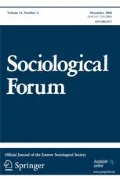Abstract
Perceptions of safety and danger are “intersubjective”—products of social construction, collective agreement, and socialization. While objective danger certainly exists, perceptions of danger do not derive directly from observation of the empirical world. The objective environment provides only inconsistent and ambiguous information, permitting ample room for socially constructed beliefs. Three cognitive frameworks—the Cautious, Confident, and Neutral frameworks—organize perceptions of safety and danger. Each framework begins with a default assumption about safety and danger and “marks” certain items as different from this default. In shaping expectations, these frameworks also contribute to perceptions of horror, humor, excitement, and fear. Finally, I use these frameworks to analyze the psychological concept “phobia” as a sociological phenomenon.
Similar content being viewed by others
References
Abrams, D., C. Abraham, R. Spears, and D. Marks 1990 “AIDS invulnerability: Relationships, sexual behavior and attitudes among 16 to 19 year olds.” In Peter Aggleton, Peter Davies, and Graham Hart (eds.), AIDS: Individual, Cultural and Policy Dimensions. London: Falmer Press.
Apter, Michael J. 1992 The Dangerous Edge: the Psychology of Excitement. New York: The Free Press.
Atlanta Constitution 1990 “Salmonella linked to tomatoes.” August 8.
Boston Globe 1992 “To the dismay of Caesar salad fans, New Jersey bans the runny egg.” January 14.
Boys' Life 1993 “Health: Foods that bite back.” July.
Chicago Tribune 1991 “Science and myth in the debate on food irradiation.” July 7.
Doctor, Robert M.,ed. 1989 The Encyclopedia of Phobias, Fears, and Anxieties. New York: Facts on File.
FDA Consumer 1987 “Risky shell game: Pet turtles can infect kids.” December.
Goodwin, Donald W. 1983 Phobia: the Facts. Oxford: Oxford University Press.
Gusfield, Joseph R. 1981 The Culture of Public Problems: Drinking-Driving and the Symbolic Order. Chicago: University of Chicago Press.
Hall, Richard C. and Michael K. Popkin 1981 “Hallucinogens: A chemical trip to Wonderland.” In Joseph S. Mule, Behavior in Excess: An Examination of the Volitional Disorders. New York: The Free Press.
Heller, Joseph 1973 Catch-22. New York: Dell Publishing Company.
Lancet 1988 “Salmonella infection from baby kangaroos.” July 16.
Memon, A. 1990 “Perceptions of AIDS vulnerability: The role of attributions and social context.” In Peter Aggleton, Peter Davies, and Graham Hart (eds.), AIDS: Individual, Cultural and Policy Dimensions. London: Falmer Press.
San Francisco Chronicle 1989 “Governor signs 80 bills, vetoes more than 30.” October 2.
Schepple, Kim Lane and Pauline B. Bart 1983 “Through women's eyes: Defining danger in the wake of sexual assault.” Journal of Social Issues. 39:63–81.
Schwarz, Conrad J. 1972 “The complications of LSD: A review of the literature.” In Douglas W. Matheson and Meredith A. Davison (eds.), The Behavioral Effects of Drugs. New York: Holt, Rinehart and Winston, Inc.
Steinman, David 1990 Diet for a Poisoned Planet: How to Choose Safe Foods for You and Your Family. New York: Harmony Books.
Svitlik, C. 1992 “Salmonella hadar associated with pet ducklings—Connecticut, Maryland, and Pennsylvania, 1991.” JAMA: The Journal of the American Medical Association 267(15):2011.
The Denver Post 1991 “A case for Johnny Apple seethe.” September 14.
The Guardian 1991 “EC urged to cut speed limits.” February 20.
The New York Times 1990 “Caution about turtle eggs.” December 27.
1992 “Irradiation approved by U.S. to rid poultry of salmonella.” September 19.
The New York Times Magazine 1989 “Trojan eggs.” July 30.
Tuan, Yi-Fu 1979 Landscapes of Fear. New York: Pantheon Books.
Washington Post 1991 “Canteloupe identified as culprit in national Salmonella outbreak.” August 16.
Woodcock, A. J., K. Stenner, and R. Ingham 1992 “Young people talking about HIV and AIDS: Interpretations of personal risk of infection.” Health Education Research: Theory and Practice.
Zerubavel, Eviatar 1991 The Fine Line: Making Distinctions in Everyday Life. New York: The Free Press.
Author information
Authors and Affiliations
Rights and permissions
About this article
Cite this article
Simpson, R. Neither clear nor present: The social construction of safety and danger. Sociol Forum 11, 549–562 (1996). https://doi.org/10.1007/BF02408392
Issue Date:
DOI: https://doi.org/10.1007/BF02408392




